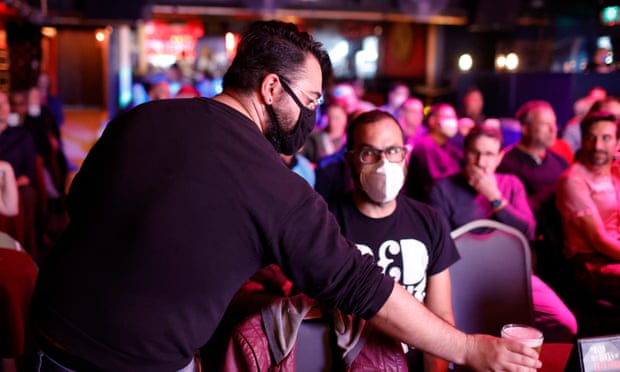A surge in Covid-19 infections, driven by the highly contagious Delta variant, has prompted San Francisco and six other counties in California’s Bay Area to reimpose mask mandates for indoor spaces, less than two months after experts in the highly vaccinated region celebrated what they hoped would be a return to normal.
In recent days, San Francisco’s infection rates have surged to nearly 20 times what they were at their lowest point in June and two of the city’s hospitals have reported that more than 200 of their own workers have tested positive for the virus.
“It teaches us that no one is invincible,” said Dr Peter Chin-Hong, an associate dean at UCSF who specializes in infectious diseases.
Research has shown the Delta variant now makes up more than 84% of all California cases, while California’s statewide reopening on 15 June meant greater social contact. Recent research shows that vaccinated people can spread the Delta virus, although they are less likely to get it and become seriously ill.
Health officials say that unvaccinated residents are being hit far harder than those who have taken the vaccine and stress that getting immunized is by far the most effective strategy for preventing hospitalization and death.
“The vaccine continues to be our best way to protect ourselves, our families and our communities. Indoor masking is a temporary measure that will help us deal with the Delta variant, which is causing a sharp increase in cases,” said Dr Naveena Bobba, San Francisco’s acting health officer, in a statement on Monday. “We know increases in hospitalizations and deaths will follow.”
Several major tech firms, including Google, Uber, Apple and Netflix, recently backtracked on plans to reopen their sprawling offices out of caution.
The surge in cases comes as California and the nation have seen continued increases in infections, with federal officials acknowledging that “the war has changed” and the new Delta variant is as contagious as chicken pox.
The return to mask wearing sees the San Francisco Bay Area join other parts of the state, including Los Angeles and Sacramento, that have already reimposed mandates as cases climb across the state.
New California cases have jumped from fewer than 900 a day at the end of May to more than 9,000 a day now, according to state data. Nationally, new cases hit a low point in late June of about 12,000 per day, but they have now shot up to more than 78,000 a day, according to data from the New York Times.
Chin-Hong was among those who thought the fact that San Francisco had vaccinated 77% of eligible residents would protect it against future surges. “At the time the state reopened, we felt invincible. But now we know we’re not,” he said.
However he predicts that high vaccination rates mean the city will avoid the huge surges in hospitalizations that have hit states like Missouri and Louisiana, where far fewer residents are vaccinated.
“We’re not filling the hospitals,” he said. “A year ago, a large number of these cases would have been admitted to the hospitals. Now people are getting symptoms of a cold.” If you’re vaccinated, he said, “you’re not going to end up on a ventilator in the hospital dying”.
Chin-Hong believes cases will level off as residents begin to reinstate masking and a few of the other precautions they had been practicing a few months ago.
On Friday, the San Francisco health department released data showing case rates among those who haven’t received the full course of vaccinations are more than twice those among fully vaccinated residents, while hospitalization rates for unvaccinated patients who get the virus are eight times higher.
“The data we are seeing shows vaccines are highly effective in protecting people from severe illness and hospitalizations due to Covid-19, even as we see some breakthrough cases,” said Dr Grant Colfax, director of health. “Getting vaccinated continues to be your best protection.”
The daily case totals for San Francisco are even higher than the peak of last summer’s Covid surge, when daily totals reached 131 cases per day. The city is now reporting 198 new cases per day – nearly 20 times what it was seeing at its low point in mid-June, when it recorded only 10 new cases per day, according to data from the city’s health department.
An analysis by the San Francisco Chronicle found the surge was partially driven by increased cases among millennials, adults aged 25 to 39. The Chronicle found that cases among that age group jumped from 35% of all new cases in May to 50% now.
Hospital officials at the University of California, San Francisco, confirmed that they had detected 183 cases among employees, while Zuckerberg San Francisco general hospital reported that 55 of its employees were out of work after recently testing positive. Both hospitals say the cases seem to be reflective of spread in the larger community and most did not stem from exposures inside the hospitals.
Of the 183 UCSF workers who tested positive, 153 had been vaccinated and 30 had not. Only two have been hospitalized – including one who was vaccinated and one who was not. None of the 55 cases at Zuckerberg San Francisco general hospital have resulted in hospitalizations.
UCSF officials said if it weren’t for the fact that more than 90% of their employees were vaccinated, they would probably be seeing much higher infection rates among their campus population of 35,000, given the high rates of spread in the community.
Cristina Padilla, public relations officer for Zuckerberg San Francisco general hospital, agreed.
“The cases among hospital staff are reflective of what’s happening in the broader community as cases have been rising,” she said. “Breakthrough cases were and still are expected. We know vaccines won’t completely prevent infections, but they are very effective at making hospitalizations and death preventable.”






